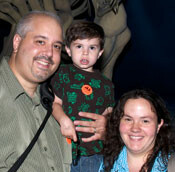Accelerating loss of seagrasses across the globe threatens coastal ecosystems
 This global assessment of 215 studies found that seagrasses have been disappearing at a rate of 110 km2 yr-1 since 1980. Rates of decline have accelerated from a median of 0.9% yr-1 before 1940 to 7% yr-1 since 1990. Seagrass loss rates are comparable to those reported for mangroves, coral reefs, and tropical rainforests and place seagrass meadows among the most threatened ecosystems on earth. Bill Dennison and Tim Carruthers from IAN were co-authors on this paper, published as an open access online article in the Proceedings of the National Academy of Science, which resulted from a series or workshops at NCEAS, UC Santa Barbara (National Center for Ecosystem Analysis and Synthesis).
This global assessment of 215 studies found that seagrasses have been disappearing at a rate of 110 km2 yr-1 since 1980. Rates of decline have accelerated from a median of 0.9% yr-1 before 1940 to 7% yr-1 since 1990. Seagrass loss rates are comparable to those reported for mangroves, coral reefs, and tropical rainforests and place seagrass meadows among the most threatened ecosystems on earth. Bill Dennison and Tim Carruthers from IAN were co-authors on this paper, published as an open access online article in the Proceedings of the National Academy of Science, which resulted from a series or workshops at NCEAS, UC Santa Barbara (National Center for Ecosystem Analysis and Synthesis).
Rock Creek Park Natural Resource Condition Assessment
 The National Park Service is currently in the process of assessing the condition of all parks with significant natural resources throughout the country. Rock Creek Park is one of the oldest National Parks in the U.S. (established in 1890) and is still a forest and wetland oasis in the heart of suburban Washington, D.C. This report uses air quality, water quality, biodiversity and ecosystem status data to assess the current condition of the three main habitat types within the park. Forests were assessed to be in fair condition, wetlands in good condition and artificial terrestrial habitats in poor condition. The report summarizes findings and links them to management implications as well as identifying major data gaps.
The National Park Service is currently in the process of assessing the condition of all parks with significant natural resources throughout the country. Rock Creek Park is one of the oldest National Parks in the U.S. (established in 1890) and is still a forest and wetland oasis in the heart of suburban Washington, D.C. This report uses air quality, water quality, biodiversity and ecosystem status data to assess the current condition of the three main habitat types within the park. Forests were assessed to be in fair condition, wetlands in good condition and artificial terrestrial habitats in poor condition. The report summarizes findings and links them to management implications as well as identifying major data gaps.
Kris Beckert joins IAN
 On July 1, IAN welcomed Kris Beckert as a Science Communicator. Kris will be working on the National Parks assessments of Assateague Island National Seashore and Kaloko-Honokohau National Historical Park, and will continue to draw cartoons as she did for the "Trade-Off!" board game. Kris grew up in the Philadelphia suburbs and completed her Bachelor of Science in Biology at the University of North Carolina at Chapel Hill. She worked as an Environmental Education Specialist for the PA Fish and Boat Commission and then came to Horn Point Laboratory for her Master's degree with Dr. Judy O'Neil, where she wrote her thesis on watershed land use and nutrient dynamics in the Maryland Coastal Bays. Kris is an avid inline skater and writer and also enjoys kayaking, reading, working at Real Life Chapel in Easton, and watching her Tar Heels beat the Terps.
On July 1, IAN welcomed Kris Beckert as a Science Communicator. Kris will be working on the National Parks assessments of Assateague Island National Seashore and Kaloko-Honokohau National Historical Park, and will continue to draw cartoons as she did for the "Trade-Off!" board game. Kris grew up in the Philadelphia suburbs and completed her Bachelor of Science in Biology at the University of North Carolina at Chapel Hill. She worked as an Environmental Education Specialist for the PA Fish and Boat Commission and then came to Horn Point Laboratory for her Master's degree with Dr. Judy O'Neil, where she wrote her thesis on watershed land use and nutrient dynamics in the Maryland Coastal Bays. Kris is an avid inline skater and writer and also enjoys kayaking, reading, working at Real Life Chapel in Easton, and watching her Tar Heels beat the Terps.
UMCES welcomes Guy Stephens
 Guy Stephens joined UMCES in July as a Senior Faculty Research Assistant / Web Developer for the Chesapeake Bay Program Office. Guy has been involved with web and application development for over a decade. He has worked with the Chesapeake Bay Program Office, The Alliance for the Chesapeake Bay, The National Park Service, Northrop Grumman, and the United States Navy. He has substantial experience designing feature-rich, user-friendly web-based solutions. Guy's educational background includes Bachelor of Science degrees in both Biology (Marine) and Environmental Marine Science from Salisbury University and the University of Maryland Eastern Shore respectively. Guy, his wife Lisa, and two young children Cooper and Audrey live in southern Calvert County and enjoy spending time at the many beautiful places throughout the Chesapeake Bay region.
Guy Stephens joined UMCES in July as a Senior Faculty Research Assistant / Web Developer for the Chesapeake Bay Program Office. Guy has been involved with web and application development for over a decade. He has worked with the Chesapeake Bay Program Office, The Alliance for the Chesapeake Bay, The National Park Service, Northrop Grumman, and the United States Navy. He has substantial experience designing feature-rich, user-friendly web-based solutions. Guy's educational background includes Bachelor of Science degrees in both Biology (Marine) and Environmental Marine Science from Salisbury University and the University of Maryland Eastern Shore respectively. Guy, his wife Lisa, and two young children Cooper and Audrey live in southern Calvert County and enjoy spending time at the many beautiful places throughout the Chesapeake Bay region.